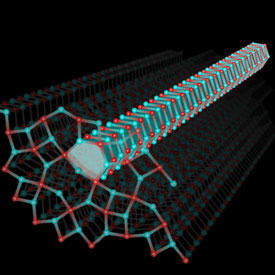

01/28/2019

Reprinted by permission from Springer Nature; Ref. 1 © 2019
A previously unknown crystallographic phase has been discovered in ceramic metal oxides by a team of AIMR researchers1. This adds to the three other known phases and promises to lead to the development of new functional devices.
Not so long ago, solids were classified as either crystalline, with well-ordered, periodic structures, or amorphous, which lack any order. This neat, two-way classification scheme was disrupted by Dan Shechtman’s discovery of quasicrystals in 1984, for which he was awarded the Nobel Prize in Chemistry in 2011. As their name suggests, quasicrystals are neither crystalline nor amorphous — they possess long-range order but are not periodic.
Now, with their discovery of a fourth crystallographic phase, Yuichi Ikuhara and his colleagues from the AIMR at Tohoku University have shown that the picture is more complicated yet.
The team discovered the new phase in thin films of two metal oxides, magnesium oxide (MgO) and neodymium oxide (Nd2O3), by using atomic-resolution scanning transmission electron microscopy. They subsequently confirmed it by performing theoretical calculations.
The researchers found the new crystallographic phase in samples made up of many small crystals of the metal oxides. Specifically, it occurred at the boundaries between two or more neighboring crystals. At these locations, the atoms have a random arrangement in two dimensions but possess translational symmetry in the third dimension, meaning that shifting the structure by a certain amount in that direction causes it to overlap with its original configuration (see image). Because of this one-dimensional (1D) order, Ikuhara’s team refers to the phase as a 1D-ordered crystal.
“It came as a surprise to us because no such structure had been reported for a simple oxide crystal such as magnesium oxide, which was thought to be either crystalline or amorphous,” Ikuhara, the team leader, says.
This new crystallographic phase is more than a scientific curiosity — it alters the properties of the material. For example, crystalline magnesium oxide is an electrical insulator, but Ikuhara’s team found that the 1D-ordered crystals of magnesium oxide are semiconducting. Ikuhara expects it will be possible to manipulate other material properties. “It should be possible to make ceramics less brittle, if we can fabricate bulk 1D-ordered crystals,” he predicts.
The team plans to further investigate the crystallographic phase. “We will study the mechanism by which 1D-ordered crystals form,” Ikuhara explains. “We also want to find out how to make larger 1D-ordered crystals in order to fabricate novel functional devices.”
This research highlight has been approved by the authors of the original article and all information and data contained within has been provided by said authors.